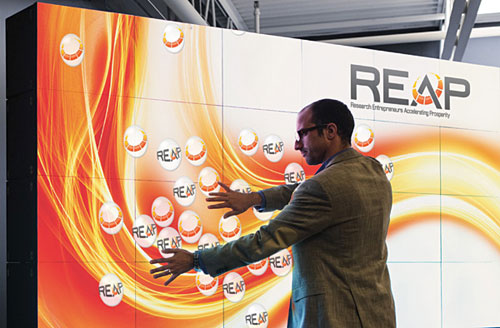Rear-Projection Tiled Digital Media Walls
Space Planning and Design Issues
Rear-projection digital display tiles are video building blocks that can be assembled to create any size and almost any shape. Instead of trying to determine where to locate large, standard-size rectangular screens, rear-projection digital display tiles allow architects design flexibility to fit the displays to a variety of orientations for any interior environment or architectural element, such as floors, walls, ceilings and even curves.
By having more options for orientation of large-scale, high-impact displays, building owners can have confidence their digital message—the content that is conveyed by the medium—reaches their intended audience within their space or facility.
A typical rear-projection tiled digital display unit measures 12 inches high by 16 inches wide and 10 inches deep. The diagonal screen size is 20 inches. The units weigh about 20 lbs each, making them lightweight enough to stack or string together.
 |
The superfine resolution of the nearly seamless interactive digital canvas allows content to be viewed close-up, at any angle. Light-absorbing, no-glare, acrylic screens are robust, durable and cool to the touch. University of Waterloo Faculty of Arts, REAP Program, Waterloo, Ontario, Canada. Photo by Quarry Integrated Communications |
Generally, a minimum clearance of 2 inches is required behind the tile units for air flow, ventilation and cabling. Larger displays may require additional back space to ensure the air behind each tile is within the operating range of 41 to 104 degrees F (5 to 40 degrees C). An inlet at the bottom of the unit allows ambient air circulation, along with vents and fans behind the display screen. The unit will automatically shut off if overheating occurs.
Each tiled unit contains a sturdy metal housing that allows the creation of a standalone display up to five tiles high, as long as the display is adequately secured to prevent tipping. Usually, the weight of each tile when stacked above five units high must be transferred to a separate supporting structure. Brackets are typically available to attach to the rear of each tile, enabling them to be mounted to a superstructure.
Rear-projection tiled digital displays can be mounted in a variety of orientations:
Wall-mounted. Floor pedestals are available, and the units can be tied back to walls and ceilings.
Suspended. Tiles can be suspended from riggings attached to the ceiling, provided a bracket is used on each tile.
Angle-mounted. Brackets can be installed on each tile for angle-mounting, with an angle of up to 20 degrees from vertical.
Floor-mounted (facing up). Rear-projection tiles are suitable for floor mounting, but cannot support bearing weight in this orientation.
Due to their light weight and small size, these modular units can fit through doorways and service elevators, and are ideal for retrofitting existing buildings where large flat-screen rectangular panels may not fit into every installation space, corridor, elevator or narrow areas.
Software is typically available for architects to design and visualize how a display will look, render the tiles and video content in a 2D or 3D space, and determine how many tiles are required.









